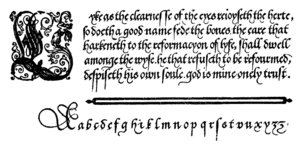John de Beauchesne facts for kids

John de Beauchesne (born around 1538 in Paris, died May 1620 in London) was a French Huguenot who became a famous teacher of handwriting and a calligrapher. A Huguenot was a French Protestant. He moved to London around 1565, during the time of Queen Elizabeth I.
In 1570, he helped write A Booke containing divers sortes of hands. This was the first book about handwriting ever published in English. John de Beauchesne also traveled to Italy and France. There, he published more books about writing. He returned to England by 1583. Later in his life, he taught handwriting to two of King James I's children: Elizabeth and Charles (who later became King Charles I). Beauchesne passed away in London in May 1620.
Contents
Life and Career of a Writing Master
John de Beauchesne was born in Paris around 1538. He was likely raised as a Huguenot, meaning he followed the Protestant faith in France. He might have been related to a family of printers and booksellers in Paris.
He moved to London around 1565. He probably came to England because it was a safer place for Protestants. By 1567, he was living in London and working as a scribe. A scribe is someone who copies documents by hand. He worked for William Bowyer, who was in charge of records at the Tower of London. John de Beauchesne created the beautiful handwritten pages in Bowyer's book, Heroica Eulogia. This book was meant for Robert Dudley, Earl of Leicester. It included paintings, coats of arms, Latin poems, and many different styles of handwriting.
Publishing the First English Writing Manual
In 1570, a French Huguenot printer named Thomas Vautrollier published Beauchesne's book, A Booke containing divers sortes of hands. This was a very important book. It was the first book of "copies" or sample alphabets for students to learn from, printed in English. The book showed 42 different woodcuts of sample alphabets and texts. These showed all the popular writing styles of the time.
This book was very successful! It was reprinted many times by Vautrollier and his next printer, Richard Field. It was reissued in 1571, 1590, 1591, 1602, and 1615. All these reissues happened while Beauchesne was still alive.
Travels and Later Works
Soon after his first book came out, Beauchesne traveled to Italy. He studied with several master calligraphers there. By 1579, he was living in Lyon, France. In 1580, he published his second book, Le Tresor d' Escriture. This book showed a strong influence from the Italian writing styles he had learned.
He came back to England by 1583. Around 1595, he published a third book on handwriting called La Clef de l'Escriture. This book was dedicated to the three daughters of Gilbert Talbot, 7th Earl of Shrewsbury. Later, he was chosen to be the writing master for Elizabeth and Charles. They were the children of the new King, James I. Beauchesne dedicated a collection of handwritten examples to Princess Elizabeth around 1610. John de Beauchesne was buried in London on May 20, 1620.
Published Works
Here are some of the important books John de Beauchesne published:
- A Booke containing divers sortes of hands (London, 1570): This book showed many different types of handwriting. It included English, French, Italian, Roman, and other styles.
- Le Thresor d'Escripture (Lyon, 1580): This book was a "treasure of writing." It contained everything needed for people who loved the art of writing.
- La Clef de l'escriture (London, around 1595): This book, meaning "The Key to Writing," helped young people learn to write French and Italian letters correctly.
Handwritten Works
These are some examples of John de Beauchesne's unique handwritten works:
- Specimens manuscrits anglais dédiés à Mme Elizabeth, fille unique du roi de Grande Bretaigne (England, around 1610): This was a collection of English handwriting examples. He dedicated it to Princess Elizabeth, King James I's daughter.
- Heroica Eulogia (London, 1567): This manuscript, created for William Bowyer, included beautiful italic and Roman calligraphic passages.
- Calligraphic specimen (1575): A special handwritten example where Beauchesne signed his name in mirror-writing.
See also
- Secretary hand
- Chancery hand
- Italic script



